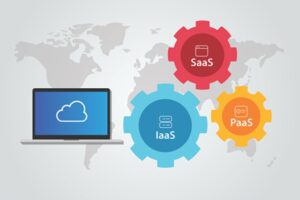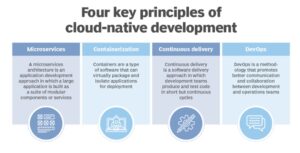Are you curious about cloud development? You’ve come to the perfect location for answers.
In this Blog, we will discuss what is Cloud Development, Cloud Native Development, Cloud Native Application Development, Cloud Application Development, and Cloud Application Development Services. Let’s get started.

What is Cloud Development?
Cloud development is the process of creating, testing, delivering, and operating software services on the cloud. Cloud software refers to programmes developed in a cloud environment. Cloud development is often referred to as cloud-based or in-cloud development. Amazon Web Services (AWS), Microsoft Azure, Google Cloud Platform, and others are well-known Cloud application development services. The widespread use of cloud services by businesses has resulted in numerous forms of cloud development based on their commercial viability.
Businesses can incorporate the most recent cloud technologies into their web apps and other Cloud application development services by utilising cloud such as multiple remote data centres, development tools, operating systems, and so on via a cloud platform as a service, software as a service, or infrastructure as a service. The Cloud application development services are based on speed, security, and resource and infrastructure flexibility. For business-driving results, cloud application development services employ cutting-edge technology and the finest of all private, public, and hybrid cloud services. Cloud application development services offer a high level of security and risk management.
Cloud Application Development
Cloud application development is the process of creating a Cloud-based programme. It entails many stages of software development, each of which prepares your programme for launch and market acceptance. DevOps approaches and tools such as Kubernetes are used by the finest Cloud application development teams. When utilised effectively with software development processes, cloud application development on cloud infrastructure allows web and PWA development services to cut development costs, open up the potential of working with remote teams, and shorten project timeframes.

What is Cloud Native Development?
Cloud Native development is designed to work seamlessly in the cloud. Developers create the architecture of Cloud Native application development from the start or heavily restructure existing code to function on the cloud utilising cloud-based technologies (Gilbert, 2018). Developers can continually and effectively deploy new software services. Cloud Native Development includes features such as continuous integration/continuous development, containers, microservices, and so on.
Cloud Native Development is centred on breaking down large software programmes into smaller services that may be utilised wherever they are needed. This guarantees that Cloud Native application development is accessible, scalable, and flexible. Microservices, cloud platforms, containers, Kubernetes, immutable infrastructure, declarative APIs, and continuous delivery technologies are commonly used in Cloud Native application development, along with approaches such as DevOps and agile methodology.
Cloud-enabled Development
The movement of traditional software to the cloud platform is known as cloud-enabled development. Cloud-enabled apps are created in a monolithic approach on on-premises hardware and resources. Cloud-enabled programmes are unable to achieve the optimum scalability and resource sharing that cloud applications provide.
Cloud-based Development
Cloud-native application development is balanced with cloud-based software development. They provide the availability and scalability of cloud services without needing major application changes. This cloud development strategy enables enterprises to use cloud benefits in certain of their services without having to change the entire software application code.

What distinguishes cloud application development from traditional app development?
Historically, software engineers would create software applications on local workstations before deploying them to the production environment. This technique increases the likelihood of software products not functioning as intended, as well as other compatibility difficulties.
Today, developers utilise agile and DevOps software development approaches, which allow for improved collaboration among development team members, allowing them to generate products effectively and follow user market expectations (Fylaktopoulos et al., 2016). Cloud application development services such as Google App Engine, code repositories such as GitHub, and so on enable developers to test, restructure, and enhance codebases in a collaborative environment before immediately deploying them to the production environment.
The Advantages of Cloud Development
Among the many advantages are:
· Cloud developers may automate several developments and testing activities.
· A cloud developer may quickly rework and enhance code without interfering with the production environment. It makes the development process more agile (Odun-Ayo, Odede and Ahuja, 2018).
· Containers and microservices enable cloud developers to create more scalable software solutions.
· DevOps development methodologies enable cloud app developers, IT employees, and clients to continually enhance the software product.
· When compared to on-premises software development, the entire process is more cost-effective, efficient, and secure.

Conclusion
The cloud computing business is massive and likely to explode in the coming years. The reason for this is the cost-effectiveness, scalability, and flexibility it brings to business processes and products, especially for small and medium-sized enterprises. A cloud-native, cloud-based, or cloud-enabled development requires a capable team of software developers that understand cloud migration and integrate best practices.






